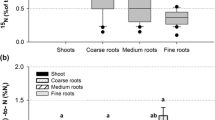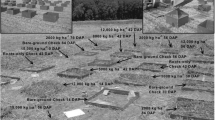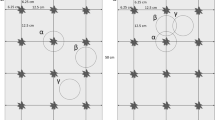Abstract
Nitrogen (N) rhizodeposition by cowpea (Vigna unguiculata (L.) Walp) is potentially a large N source in cropping systems of Sub-Saharan Africa. A field experiment was conducted to measure cowpea N rhizodeposition under the conditions of the Sudano-Sahelian zone using direct 15N labelling techniques to trace the amount of deposition and its transfer to associated and subsequent crops. Half of the total cowpea crop N was located below-ground at plant maturity, which exceeded 20 kg N ha−1 when intercropped with millet. Only 15% of the below-ground cowpea N was recovered in roots, while 85% was found in the rhizodeposited pools. The experiment demonstrated that direct below-ground N transfer occurred from cowpea to millet in intercrop at a rate of 2 kg N ha−1 over the growing season. Forty percent of the 25 kg below-ground N that the cowpea crop left at harvest were identifiable in the top 0.30 m soil in the beginning of the next planting season 7 months later; a pool still present at the end of that second season. Thus, the subsequent crop of millet (Pennisetum glaucum (L.) R. Br.) only recovered 2.5 kg N ha−1 from the below-ground cowpea pre-crop N during this growth season. The role and potential of cowpea as N provider has been underestimated in the past by ignoring the large proportion of N contained in its rhizodeposits. However, information is needed to determine how losses of the rhizodeposited N can be minimized to fully harness the potential of cowpea as N provider in agro-ecosystems of the region.



Similar content being viewed by others
References
Adjei-Nsiah S, Kuyper TW, Leeuwis C, Abekoe MK, Cobbinah J, Sakyi-Dawson O, Giller KE (2008) Farmers’ agronomic and social evaluation of productivity yield and N2-fixation in different cowpea varieties and their subsequent residual N effects on a succeeding maize crop. Nutr Cycl Agroecosys 80:199–209
Alvey S, Bagayoko M, Neumann G, Buerkert A (2001) Cereal/legume rotations affect chemical properties and biological activities in two West African soils. Plant Soil 231:45–54
Araujo ES, Boddey RM, Urquiaga S, Alves BJR (2006) Soybean below-ground N and its contribution to the N nutrition of a subsequent sorghum crop. Paper presented at 18th World Congress of Soil Science, Philadelphia, Pennsylvania, USA, 9–15 July 2006
Bado B, Bationo A, Cescas M (2006) Assessment of cowpea and groundnut contributions to soil fertility and succeeding sorghum yields in the Guinean savannah zone of Burkina Faso (West Africa). Biol Fertil Soils 43:171–176
Bagayoko M, Mason SC, Traore S, Eskridge KM (1996) Pearl millet/cowpea cropping systems yield and soil nutrient levels. Afr Crop Sci J 4:453–462
Bagayoko M, Mason SC, Traoré S (1998). The role of cowpea on pearl millet yield, N uptake and soil nutrient status in millet–cowpea rotation in Mali. In: Renard G, Neef A, Becker K, von Oppen M (eds) Soil fertility management in West African land-use systems, Margraf Verlag Weikersheim, Germany. pp 109–114
Bagayoko M, Buerkert A, Lung G, Bationo A, Romheld V (2000) Cereal/legume rotation effects on cereal growth in Sudano-Sahelian West Africa: soil mineral nitrogen, mycorrhizae and nematodes. Plant Soil 218:103–116
Bationo A, Ntare BR, Tarawali SA, Tabo R (2002) Soil fertility management and cowpea production in the semi-arid tropics. In: Fatokun CA, Tarawali SA, Singh BB, Kormawa PM, Tamò M (eds) Challenges and opportunities for enhancing sustainable cowpea production. Proceedings of the World Cowpea Conference III held at the International Institute of Tropical Agriculture (IITA), Ibadan, Nigeria, 4–8 September 2000. IITA, Ibadan, Nigeria. pp 301–318
Bationo A, Traore Z, Kimetu J, Bagayoko M, Bado V, Lompo M, Tabo R, Koala S (2004) Cropping systems in the Sudano-Sahelian zone: implications on soil fertility management. Centro Internacional de Agricultura Tropical (CIAT), Tropical Soil Biology and Fertility (TSBF), Nairobi. pp 34
Bernhardt-Reversat S (1982) Biogeochemical cycle of nitrogen in a semi-arid savanna. Oikos 38:321–332
Bielders CL, Michels K, Rajot JL (2000) On-farm evaluation of ridging and residue management practices to reduce wind erosion in Niger. Soil Sci Soc Am J 64:1776–1785
Birch HF (1964) Mineralization of plant nitrogen following alternate wet and dry conditions. Plant Soil 20:43–49
Eaglesham ARJ, Ayanaba A, Rao VR, Eskew DL (1982) Mineral N effects on cowpea and soybean crops in a Nigerian soil. 2. Amounts of N fixed and accrual to the soil. Plant Soil 68:183–192
FAO (1988) FAO Soil Map of the World, revised legend. World Soil Resources Report 60, Food and Agricultural Organization, Rome
FAO (2004) Sahel weather and crop situation. Report No 2. Global information and early warning system on food and agriculture. Food and Agricultural Organization, Rome
Fofana B, Wopereis M, Bationo A, Breman H, Mando A (2008) Millet nutrient use efficiency as affected by natural soil fertility, mineral fertilizer use and rainfall in the West African Sahel. Nutr Cycl Agroecosyst 81:25–36
Franke AC, Laberge C, Oyewole BD, Schulz S (2008) A comparison between legume technologies and fallow, and their effects on maize and soil traits, in two distinct environments of the West African savannah. Nutr Cycl Agroecosyst 82:117–135
Fussell LK, Serafini PG (1985) Associations de cultures dans les zones tropicales semi-arides d’Afrique de l’Ouest: stratégies de recherché antérieures et futures. In: Ohm HW, Nagy JG (eds) Technologies appropriées pour les paysans des zones semi-arides de l’Afrique de l’Ouest. Purdue University, West Lafayette, pp 254–278
Gandah M, Brouwer J, Hiernaux P, Van Duivenbooden N (2003) Fertility management and landscape position: farmers’ use of nutrient sources in western Niger and possible improvements. Nutr Cycl Agroecosyst 67:55–66
Giller KE (2002) Nitrogen fixation in tropical cropping systems. CABI Publishing, Wallingford, p 352
Giller KE, Witty JF (1987) Immobilized 15N-fertilizer sources improve the accuracy of field estimates of N2-fixation by isotope dilution. Soil Biol Biochem 19:459–463
Giller KE, Ormesher J, Awah FM (1991) Nitrogen transfer from Phaseolus bean to intercropped maize measured using 15N-enrichment and 15N-isotope dilution methods. Soil Biol Biochem 23:339–346
Gylfadóttir T, Helgadóttir Á, Høgh-Jensen H (2007) Consequences of including adapted white clover in northern European grassland: transfer and deposition of nitrogen. Plant Soil 297:93–104
Hayashi K, Abdoulaye T, Gerard B, Bationo A (2007) Evaluation of application timing in fertilizer micro-dosing technology on millet production in Niger, West Africa. Nutr Cycl Agroecosyst 80:257–265
Hertenberger G, Wanek W (2004) Evaluation of methods to measure differential 15N labelling of soil and rood N pools for studies of root exudation. Rapid Commun Mass Spectrom 18:2415–2425
Høgh-Jensen H, Schjoerring JK (2001) Rhizodeposition of nitrogen by red clover, white clover and ryegrass leys. Soil Biol Biochem 33:439–448
Høgh-Jensen H, Nielsen B, Thamsborg SM (2006) Productivity and quality, competition and facilitation of chicory in ryegrass/legume-based pastures under various nitrogen supply levels. Eur J Agron 24:247–256
IAEA (2004) Use of isotope and radiation methods in soil and water management and crop nutrition, an interactive CD. IAEA, Vienna
Jenkinson DS, Fox RH, Rayner JH (1985) Interactions between fertilizer nitrogen and soil nitrogen-the so-called “priming” effect. J Soil Sci 36:425–444
Khan DF, Peoples MB, Herridge DF (2002) Quantifying below-ground nitrogen of legumes - 1. Optimising procedures for 15N shoot-labelling. Plant Soil 245:327–334
Khan DF, Peoples MB, Schwenke GD, Felton WL, Chen DL, Herridge DF (2003) Effects of below-ground nitrogen on N balances of field-grown fababean, chickpea, and barley. Aust J Agric Res 54:333–340
Laberge G, Franke AC, Ambus P, Høgh-Jensen H (2009) Nitrogen rhizodeposition from soybean (Glycine max) and its impact on nutrient budgets in two contrasting environments of the Guinean savannah zone of Nigeria. Nutr Cycl Agroecosyst 84:49–58
McNeill AM, Zhu CY, Fillery IRP (1997) Use of in situ 15N-labeling to estimate the total below-ground nitrogen of pasture legumes in intact soil-plant systems. Aust J Agric Res 48:295–304
Merbach W, Mirus E, Knof G et al (1999) Release of carbon and nitrogen compounds by plant roots and their possible ecological importance. J Plant Nutr Soil Sci 162:373–383
R Development Core Team (2007) R: a language and environment for statistical computing. R Foundation for Statistical Computing. Available via http://www.R-project.org. Cited 2 April 07
Samake O, Stomph T, Kropff M, Smaling E (2006) Integrated pearl millet management in the Sahel: effects of legume rotation and fallow management on productivity and Striga Hermonthica infestation. Plant Soil 286:245–257
Sanginga N, Dashiell KE, Diels J et al (2003) Sustainable resource management coupled to resilient germplasm to provide new intensive cereal-grain-legume-livestock systems in the dry savanna. Agric Ecosyst Environ 100:305–314
Schmidtke K (2005) How to calculate nitrogen rhizodeposition: a case study in estimating N rhizodeposition in the pea (Pisum sativum L.) and grasspea (Lathyrus sativus L.) using a continuous 15N labelling split-root technique. Soil Biol Biochem 37:1893–1897
Semb G, Robinson JBD (1969) The natural nitrogen flush in different arable soils and climates in East Africa. E Afr Agric For J 34:350–370
Shahandeh H, Blanton-Knewtson SJ, Doumbia M, Hons FM, Hossner LR (2004) Nitrogen dynamics in tropical soils of Mali, West Africa. Biol Fertil Soils 39:258–268
Singh BB, Ajeigbe HA, Tarawali SA, Fernandez-Rivera S, Abubakar M (2003) Improving the production and utilization of cowpea as food and fodder. Field Crops Res 84:169–177
Tabo R, Bationo A, Diallo Maimouna K, Hassane O, Koala S (2005) Fertilizer micro-dosing for the prosperity of smallscale farmers in the Sahel. Final Report, ICRISAT, Niamey
Vesterager JM, Nielsen NE, Høgh-Jensen H (2007) Nitrogen budgets in crop sequences with phosphorus fertilisation with or without cowpea in the maize-based cropping systems of semi-arid eastern Africa. Afr J Agric Res 2:261–268
Vesterager JM, Nielsen NE, Høgh-Jensen H (2008) Effects of cropping history and phosphorus source on land and nitrogen uptake efficiency in sole or intercropped cowpea maize crops. Nutr Cycl Agroecosyst 80:61–73
Voortman RL, Brouwer J, Albersen PJ (2004) Characterization of spatial soil variability and its effect on millet yield on Sudano-Sahelian coversands in South-West Niger. Geoderma 121:65–82
Wichern F, Eberhardt E, Mayer J, Joergensen RG, Muller T (2008) Nitrogen rhizodeposition in agricultural crops: methods, estimates and future prospects. Soil Biol Biochem 40:30–48
Witty JF, Roose E (1984) Slow-release 15N fertilizer formulations to measure N2-fixation by isotope dilution. Soil Biol Biochem 16:657–661
Yasmin K, Cadisch G, Baggs EM (2006) Comparing 15N-labelling techniques for enriching above- and below-ground components of the plant-soil system. Soil Biol Biochem 38:397–400
Acknowledgments
The authors wish to thank Tahirou Saley and Amadou Mounkeila along with Chindo, Tindi and Issaka Kouarokoye for their skilled technical assistance. The contributions of Dr. Matsunaga and the JIRCAS program at ICRISAT who provided the cowpea seeds and the millet breeding program of ICRISAT who provided the millet seeds should also be acknowledged.
Author information
Authors and Affiliations
Corresponding author
Additional information
Responsible Editor: Elizabeth M. Baggs.
Rights and permissions
About this article
Cite this article
Laberge, G., I. G. Haussmann, B., Ambus, P. et al. Cowpea N rhizodeposition and its below-ground transfer to a co-existing and to a subsequent millet crop on a sandy soil of the Sudano-Sahelian eco-zone. Plant Soil 340, 369–382 (2011). https://doi.org/10.1007/s11104-010-0609-6
Received:
Accepted:
Published:
Issue Date:
DOI: https://doi.org/10.1007/s11104-010-0609-6




